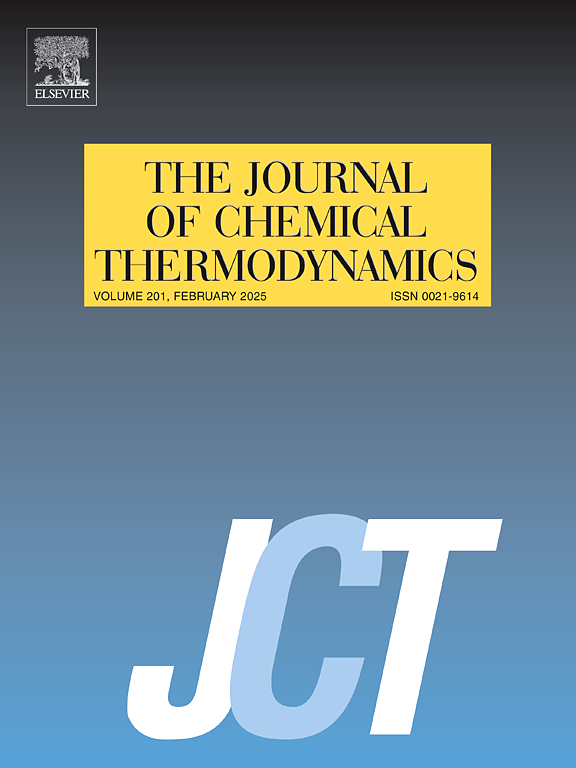Ionic speciation and volumetric properties modeling of the ternary system CuCl2 – HCl – H2O from 273.15 to 373.15 K and at 101.3 kPa using the Pitzer equations
IF 2.2
3区 工程技术
Q3 CHEMISTRY, PHYSICAL
引用次数: 0
Abstract
This work develops a thermodynamic model for ionic speciation and volumetric properties of the ternary system CuCl2 – HCl – H2O from 273.15 to 373.15 K and at 101.3 kPa, a system relevant to chalcopyrite leaching in chloride media and hydrogen production via the copper–chlorine thermochemical cycle. The Pitzer equations were used to estimate water activities, CuCl2·2H2O(cr) solubilities, and densities, calibrated using published experimental data. The speciation model includes Cu2+, H+, CuCl+, Cl–, , and HCl0, showing reasonable species distribution results as a function of temperature and total concentration. Based on volume of mixing calculations at 298.15 K, CuCl2 acts as a structure breaker of water, while HCl behaves as a structure maker. New Pitzer parameters and the solubility product constant of CuCl2·2H2O(cr) are provided as temperature–dependent functions. The model demonstrates high accuracy in reproducing experimental data and offers insights into the physicochemical behavior of concentrated CuCl2 + HCl + H2O solutions.
在273.15 ~ 373.15 K和101.3 kPa条件下,CuCl2 - HCl - H2O三元体系的离子形态和体积性质用Pitzer方程建模
本研究建立了在273.15 ~ 373.15 K和101.3 kPa范围内CuCl2 - HCl - H2O三元体系离子形态和体积性质的热力学模型,该体系与氯化物介质中黄铜矿的浸出和通过铜-氯热化学循环产氢有关。Pitzer方程用于估算水活度、CuCl2·2H2O(cr)溶解度和密度,并使用已发表的实验数据进行校准。物种形成模型包括Cu2+、H+、CuCl+、Cl -、CuCl20和HCl0,物种分布结果随温度和总浓度的变化较为合理。根据298.15 K下的混合体积计算,CuCl2是水的结构破坏者,而HCl则是结构制造者。给出了CuCl2·2H2O(cr)的新Pitzer参数和溶解度积常数作为温度相关函数。该模型在再现实验数据方面具有较高的准确性,并为CuCl2 + HCl + H2O浓溶液的物理化学行为提供了见解。
本文章由计算机程序翻译,如有差异,请以英文原文为准。
求助全文
约1分钟内获得全文
求助全文
来源期刊

Journal of Chemical Thermodynamics
工程技术-热力学
CiteScore
5.60
自引率
15.40%
发文量
199
审稿时长
79 days
期刊介绍:
The Journal of Chemical Thermodynamics exists primarily for dissemination of significant new knowledge in experimental equilibrium thermodynamics and transport properties of chemical systems. The defining attributes of The Journal are the quality and relevance of the papers published.
The Journal publishes work relating to gases, liquids, solids, polymers, mixtures, solutions and interfaces. Studies on systems with variability, such as biological or bio-based materials, gas hydrates, among others, will also be considered provided these are well characterized and reproducible where possible. Experimental methods should be described in sufficient detail to allow critical assessment of the accuracy claimed.
Authors are encouraged to provide physical or chemical interpretations of the results. Articles can contain modelling sections providing representations of data or molecular insights into the properties or transformations studied. Theoretical papers on chemical thermodynamics using molecular theory or modelling are also considered.
The Journal welcomes review articles in the field of chemical thermodynamics but prospective authors should first consult one of the Editors concerning the suitability of the proposed review.
Contributions of a routine nature or reporting on uncharacterised materials are not accepted.
 求助内容:
求助内容: 应助结果提醒方式:
应助结果提醒方式:


